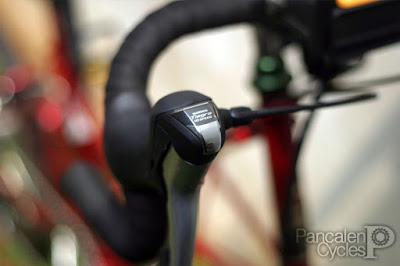Working on bicycle repair business for quite a while, we occasionally stumbled upon some iconic bicycles from different eras. This just goes to show that even though it was agreed that the conventional double-triangle or diamond design is regarded as the most efficient means to construct a bicycle frame, some people went through further means to think out of the box and created something that will be remembered forever; whether to achieve significant improvement or just to be able to stand out of the crowd.
If you ride or have an adult-sized, small-wheeled bicycle in your stable you're most likely owed an appreciation to Dr. Alex Moulton. Educated at Marlborough College and King's College, Cambridge, he was the great-grandson of the rubber pioneer Stephen Moulton, the founder of the family business George Spencer Moulton & Co. Ltd., in which he worked after World War II, specialising in rubber suspension systems for vehicles.
As soon as the family business was bought by Avon Rubber Company, Dr. Moulton started up Moulton Developments Limited to design the suspension system for British Motor Corporation's new small car, the Morris Mini, that was being designed by his friend Sir Alec Issigonis. The combination of conical rubber springs and small wheels was one of the many innovative developments that allowed Issigonis to achieve the Mini's small, distinctive overall size.
Prompted by the oil shock caused by the Suez Crisis, in 1956 Dr. Moulton started work on designing bicycles. Naturally, his work was inspired by his automotive developments by incorporating small wheels and rubber-based suspension system, creating compact sized bicycles that will perform similar to or even surpass full-sized bicycles. Eventually in 1962, at the Earls Court Cycle Show, the first Moulton Bicycle with frame shaped like a letter F laid on its side was launched.
The first spaceframe Moulton design—similar as the one featured here—was introduced in 1983, after six years of conceptual development to reconcile the seemingly unsolvable demands of the open, stiff frame and the need for lightness. Other than the distinctive spaceframe design and 20" wheels, the frame also featured front and rear rubber-based suspension. Later this design was used as base for the AM-ATB off road bicycle that was introduced in 1988, and credited as the first full-suspension mountain bike—all together now, in your best Jeremy Clarkson voice—in the world.
 |
| The APB is a demountable. Unscrew the large Allen bolt and the lower black knurled thingy there to split it in half. |
 |
| Those cable splitters are there so you don't have to readjust your derailers/brake after you disassemble the frame. |
 |
| Besides acting as suspension pivot, the bolt near the bottom bracket shell splits the rear triangle from the front. |
 |
| Front suspension damper, hidden inside the steerer. |
 |
| The fork is a leading-link front suspension. Simple and effective. |
 |
| Rear suspension rubber damper. |
This maroon 1998 Moulton APB T21 was brought to our shop for a once over after the owner bought it used, but then we found out that the original Sachs 3 x 7 DualDrive rear hub was trashed. The original Shimano RSX brake levers are also paired to Tektro long-pull V-brakes, leading to poor braking performance caused by the cable pull ratio incompatibility. The owner also wanted to ride on wider tires. There will be a lot of work and nothing left except the frame, the cockpit, the non-original rims, and the crankset/bottom bracket, so we cue the music.
Since the 3 x 7 DualDrive is rarer than hen's teeth here we opt for its much younger sibling, the SRAM DualDrive II (fun fact: Sachs was bought by SRAM in 1997). As the name stated, DualDrive hubs are basically 3-speed internal gear hub with freehub body that can accept conventional cassettes. In case of DualDrive II, the freehub body is designed to accept 8-speed or 9-speed cassette, this means that they can accept 10-speed or even Shimano's new 11-speed MTB cassette. Since we'll be using Shimano Tiagra 3 x 10-speed shifters, we used the widest range cassette that the new medium cage road derailer can handle, 11-34T.
Another thing, the DualDrive was not designed for dropbar shifters so we have to improvise the front shift cable adjustment to make the internal gear hub shifts perfectly. Apart from relacing the old rim to the new DualDrive II hub, we took our time to fix the front wheel as well; the spokes were way too long for the application so we shorten and relace them in 2-cross pattern.
The APB T21 was originally equipped with 20 x 1-1/8" tires. As the result of switching to short-pull Promax V-brakes and wider Maxxis Gypsy 20 x 1.50" tires—about 10mm wider than original—we have to ditch the original fenders. The better traction offered by wider tires and much improvement on braking performance outweighs the impracticality of not having fenders (or mudguards, in proper British), in our humble opinion. Since the setup will be using entirely new cable set, we took our time to hide the speed sensor cable.









Hello from Wiltshire, England. I have recently come into possession of a T21 and love it! It is very original and the only components on the whole machine I dislike are the mentioned Tektro V-Brakes. They work OK but are plug ugly and huge, so are being replaced with low profile Canti's (necessary for heel clearance on the rear). This model was designed for cantilever brakes anyway, so bolt straight on with no modification. My machine also came with a seized front end. Do not use any other lubricant for the spring and bearing (a plastic bobbin sited above the ride height adjuster) than SILICON GREASE. I modified the existing bobbin and now all is well. I can offer advise for strip down and repair to anyone with similar problems. grphoto@hotmail.co.uk. Enjoy!
ReplyDelete